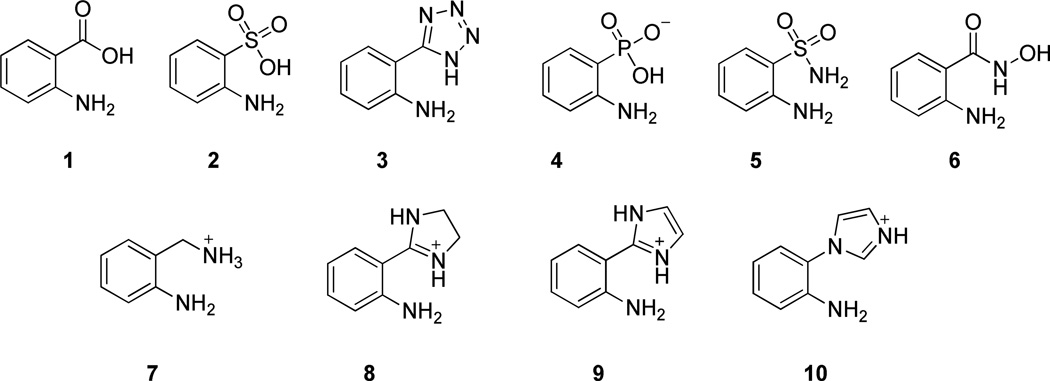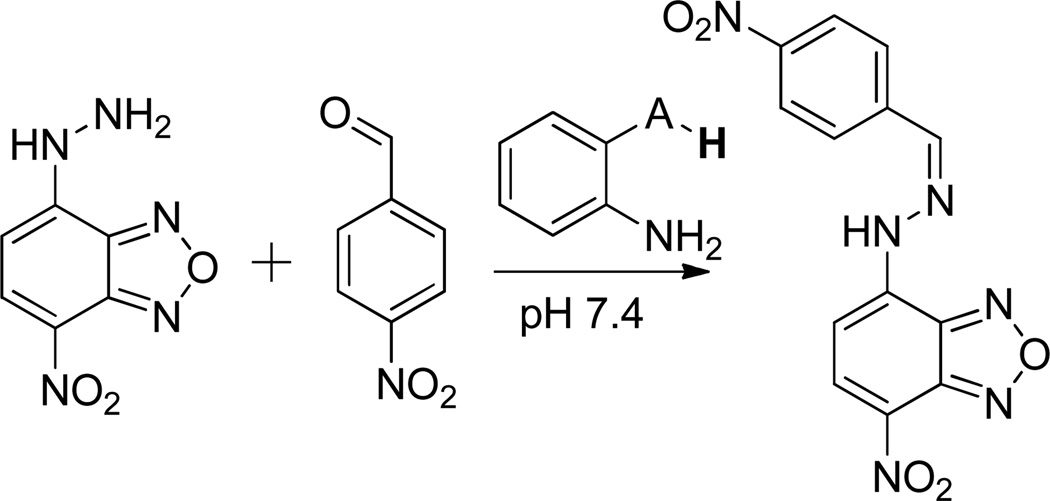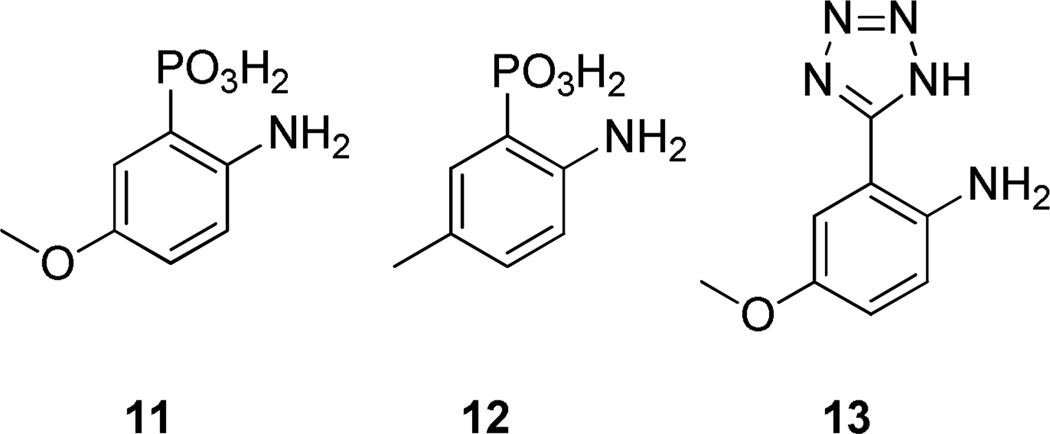Abstract

Anthranilic acids were recently reported as superior catalysts for hydrazone and oxime formation compared to aniline, the classic catalyst for these reactions. Here, alternative proton donors were examined with varied pKa in an effort to enhance activity at biological pH. The experiments show that 2-aminobenzenephosphonic acids are superior to anthranilic acids in catalyzing hydrazone formation with common aldehyde substrates.
The rapid development of bioorthogonal reactions has been broadly important for applications in bioconjugation chemistry.1,2 Common goals of this research include increased specificity while avoiding cross-reactivity with biological components, and increasing reaction rates. Recent useful developments in the field such as strain-promoted click chemistry and Diels-Alder reactions of tetrazines and strained alkenes have provided relatively rapid reactions that can be performed at moderately low reactant concentrations.3–5 However, the adoption and application of these reactions has required specialized substrates that are not always readily synthetically accessible and can have limited aqueous solubility. Additional bioorthogonal reactions are still sought in order to carry out multiple distinct modifications of biomolecules, and to provide synthetic flexibility.
A considerably older bioorthogonal reaction, hydrazone / oxime formation, has proven quite generally useful in bioconjugations. Many aldehydes, hydrazines and aminooxy compounds are widely available and can be readily synthetically accessed.1,6 However, the slow rate of product formation, particularly at biological pH, has placed limits on the utility of this reaction in the past.7 An important improvement was reported by Dawson, building upon the early work of Jencks, who found that aniline acts as a useful nucleophilic catalyst for the reaction.7–10 The synthetic accessibility of the substrates and the development of this catalysis has led to a considerable growth in the applications of hydrazone and oxime formation for bioorthogonal labeling as well as in other fields, such as dynamic covalent chemistry.1,2,8–14
However, the use of aniline as a nucleophilic catalyst is still less than ideal, as large concentrations of the compound (10 – 100 mM) are required to yield useful rates.7–9,14 Alternatively, more acidic buffers can improve aniline catalysis, although 10 mM catalyst is still recommended.14,15 Unfortunately, acidic pH can be detrimental to some biomolecules, not to mention unachievable in cells. As a result, the development of improved nucleophilic catalysts for hydrazone- and oxime-forming reactions would be of considerable utility in bioorthogonal conjugations.7
Recently we reported that anthranilic acid and its derivatives can serve as catalysts superior to aniline for hydrazone formation at biological pH.16 At 1 mM catalyst concentration, 5-methoxyanthranilic acid (5MA) displayed a greater than 5-fold advantage over aniline in the second-order rate constant for hydrazone formation, while higher concentrations afforded an advantage of over 100-fold.16 We hypothesized that the ortho carboxylic acid of these compounds was the primary source of the enhanced catalysis, serving as an intramolecular proton donor during imine and hydrazone formation.16 Indeed, modification of the carboxylic acid to nonacidic derivatives (e.g. anthranilamide or anthranilonitrile) eliminated catalytic activity.16 However, the low pKa of the carboxylate group in anthranilic acid (2.18)17 implies that very little of the catalyst exists in the presumed active protonated state at neutral pH. Thus we reasoned that developing new derivatives with a pKa closer to that of biological buffers could provide further rate enhancements.
To examine the role of the pKa of the proton donor, we explored moieties that could serve as carboxylic acid surrogates in the anthranilic acid scaffold (Figure 1). We started with simple carboxylic acid replacements, such as sulfonic acid, tetrazole, phosphonic acid, hydroxamic acid, and sulfonamide. Similarly, we tested conjugate acids of basic moieties, choosing amine or imidazole functionalities. We tested the new catalyst analogs with the chromogenic reaction between NBD hydrazine and 4-nitrobenzaldehyde (Scheme 1), which yields an increase in absorbance at 504 nm with hydrazone formation.16
Figure 1.
Structures of nucleophilic catalysts for hydrazone formation having ortho proton donors of varied pKa.
Scheme 1.
Colorimetric reaction for monitoring hydrazone formation
Plots of reactions are shown in Fig. S1 (Supporting Information (SI)), and apparent second-order rate constants are given in Table 1. 2-Aminobenzenesulfonic acid 2, with a pKa far below the buffer pH, performed poorly as expected (Table 1, Figure S1), and was inferior to aniline itself, likely because the strongly electron-withdrawing sulfonate lowers nucleophilicity of the amine. Indeed, the sulfonate group in compound 2 reduces the pKa of the anilinic nitrogen from the 4.6 of aniline to 2.5.18 As the pKa of the acidic moieties increased, catalytic activity was observed to increase as well. Most notably, 5-(2-aminophenyl)tetrazole 3 was superior to aniline, and only slightly less active than anthranilic acid. This is reasonable, considering the similar pKa values of benzoic acid and 5-phenyltetrazole (4.19 and 4.30 respectively).19 2-aminobenzenephosphonic acid 4, with a pKa of 7.29,20 was almost fourfold more active than aniline and displayed a two-fold improvement in rate constant over anthranilic acid. As the pKa of the acid moiety increased further, to 2-aminobenzenehydroxamic acid 6 (pKa = 9.2921) or 2-aminobenzenesulfonamide 5 (pKa = 10.022), catalytic activity at pH 7.4 fell dramatically. These results indicate that the pKa of the proton donor has great importance and suggest that a pKa near that of the solution pH may provide optimal catalysis (see Figure S2).
Table 1.
Apparent 2nd order rate constants (M−1 min−1) for different ortho proton donor nucleophilic catalysts.a
| catalyst | pKab | 2nd order rate constant | rel. to uncat. rxn. |
|---|---|---|---|
| (none) | -- | 0.10 ± 0.01 | 1 |
| aniline | -- | 1.1 ± 0.1 | 11 |
| 1 | 2.18 | 2.3 ± 0.3 | 22 |
| 2 | −1.41 c | 0.14 ± 0.03 | 1.4 |
| 3 | -- | 1.7 ± 0.2 | 16 |
| 4 | 7.29 | 4.1 ± 0.2 | 40 |
| 5 | 10.0 | 0.09 ± 0.03 | 0.8 |
| 6 | 9.29 | 0.25 ± 0.06 | 2.5 |
| 7 | 9.60 c | 0.04 ± 0.02 | 0.4 |
| 8 | 9.78 c | 0.03 ± 0.01 | 0.3 |
| 9 | 6.51 c | 0.05 ± 0.06 | 0.5 |
| 10 | 5.63 c | 0.12 ± 0.03 | 1.2 |
Reaction conditions: 18 µM NBD Hydrazine, 1 mM 4-nitrobenzaldehyde, 1 mM catalyst in 10:1 PBS (pH 7.4):DMF, 23 °C. Reaction monitored at 504 nm.
pKa values of acidic moiety from literature (see text for references).
pKa calculated by ACD/Labs (V11.02 © 1994–2013); no literature value available.
Interestingly, the cationic conjugate acids of basic functional groups displayed strongly contrasting behavior, with the imidazoles and amines showing a near-complete lack of reactivity in catalyzing hydrazone formation despite relatively favorable pKa values of the proton donors (Table 1, Figure S3). We hypothesize that positively charged groups conjugated to the ortho amine lower its nucleophilicity more than neutral or negatively charged groups do.
Since the mechanism of catalysis by anilines and anthranilic acids involves nucleophilic catalysis via an imine intermediate, it is clearly important that a catalyst maintain nucleophilicity in the anilinic nitrogen. This was indicated by the activity of anthranilic acid, which has amine basicity similar to that of aniline.17 2-Aminobenzenesulfonic acid 2 demonstrates the adverse effect of a strongly electron-withdrawing ortho substituent. The superior new catalyst 2-aminobenzenephosphonic acid 4, however, maintains a reasonably basic aniline pKa of 4.1.20
We sought to test the mechanism of catalysis by aminobenzenephosphonic acid derivatives to observe similarities and differences with anthranilic acid and aniline. Previous studies of catalyst imine formation showed that anthranilic acid forms a relatively unstable imine intermediate, with imine formation acting as the rate-limiting step (consistent with the aniline-catalyzed reaction).10,16,23 Similar studies performed with 2-aminobenzenephosphonic acid yielded no spectroscopically observable imine formation at 1 mM catalyst, suggesting the imine-forming equilibrium lies considerably to the side of free aldehyde and catalyst (Figure S4). In further studies, we confirmed that the rate-determining step in hydrazone formation catalyzed by phosphonic acid 4 is imine formation: varying NBD hydrazine concentration gave no significant change in reaction rates under the conditions tested (Table S1, Figure S5).
Next we sought to optimize the 2-aminobenzenephosphonic acid framework to further improve catalytic efficiency. We hypothesized that that modification of the 5-position of the aromatic ring with electron-donating groups might enhance the basicity and nucleophilicity of the amine.16 To this end, we prepared 5-methoxy-2-aminobenzenephosphonic acid 11 and compared its activity to 5-methoxyanthranilic acid (5MA), which was previously determined to be an optimal anthranilic acid derivative.16 Despite displaying a greatly improved initial reaction rate, compound 11 lost much of its catalytic ability after approximately 30 minutes in buffer. Use of deoxygenated buffer did not prevent the loss of activity (data not shown), indicating a degradation pathway other than oxidation. As an alternative, we prepared 5-methyl-2-aminobenzenephosphonic acid 12. We were gratified to observe that not only was this derivative stable in buffer, but also afforded further enhanced catalysis, with a 2nd order rate constant almost 8-fold higher than aniline catalysis in hydrazone formation at 1 mM catalyst concentration (Table 2, Fig. S6). Control reactions showed that the catalyst, hydrazine, and aldehyde were all required for efficient reaction as expected (Fig. S7). In an analogous experiment, we also prepared a 5-methoxy derivative of the tetrazole catalyst (13) and this also showed improved catalysis, with activity similar to that of 5MA, the previous best catalyst for this reaction.
Table 2.
Apparent 2nd order rate constants (M− 1 min− 1) for different ortho proton donor nucleophilic catalysts.a
| catalyst | 2nd order rate constant | rel. to uncat. rxn. |
|---|---|---|
| (none) | 0.10 ± 0.01 | 1 |
| 1.1 ± 0.1 | 11 | |
 |
4.7 ± 0.3 | 46 |
 |
5.0 ± 0.7 | 49 |
 |
8.5 ± 0.5 | 83 |
 |
5.4 ± 0.7 | 53 |
Conditions: 18 µM NBD Hydrazine, 1 mM 4-nitrobenzaldehyde, 1 mM catalyst in 10:1 PBS (pH 7.4):DMF, 23 °C.
We proceeded to explore the substrate scope of the new phosphonic acid and tetrazole catalysts relative to aniline and anthranilates. We were particularly interested in whether the increased size and added negative charge of the phosphonic acid of 4 and 12 relative to a carboxylic acid might be problematic on certain substrates. Data are shown in Table 3 (also see Figs. S8 – S18). In general, the new compounds displayed enhanced catalysis with a range of electron-rich and electron-poor benzaldehyde derivatives, with 12 proving superior in most cases to the previous best catalyst 5MA. 2-formylpyridine also served as a good substrate for 12 and 13, and was the fastest aromatic substrate of all. Tests with an aliphatic aldehyde, butyraldehyde, showed a particularly rapid reaction, with 5MA, 12 and 13 proving most efficient. We also tested reactivity with 2-butanone to assay for catalysis with aliphatic ketones, but observed only negligible product formation even after extended reaction, consistent with reports that NBD hydrazine reacts poorly with ketones at pH 7.4.24 Like the anthranilic acids, the new analogs were not suitable for more hindered substrates such as acetophenone.16 Overall, the substrate studies show that sterically unhindered aldehydes are the best suited for catalysis by aminobenzenephosphonic acids such as 12, and that 5MA or the new tetrazole 13 are preferable if there is steric or electronic interference.
Table 3.
Substrate scope of catalysts as measured by hydrazone yields (%) with aldehydes and ketones after 4 h reaction.a
| catalyst substrate |
(none) | aniline | 5MA | 4 | 12 | 13 |
| benzaldehyde | 1.1 | 4.1 | 9.4 | 10 | 17 | 7.7 |
| p-anisaldehyde | 0.3 | 1.4 | 2.3 | 2.3 | 4.8 | 1.9 |
| 4-carboxy-benzaldehyde | 3.6 | 26 | 44 | 28 | 40 | 39 |
| 2-carboxy-benzaldehyde | 7.9 | 68 | 99 | 36 | 65 | 98 |
| 4-chloro-benzaldehyde | 2.8 | 9.4 | 26 | 35 | 46 | 17 |
| 2-formyl-pyridine | 11 | 82 | 99 | 94 | 72 | 92 |
| 4-formyl-pyridine | 3.3 | 29 | 55 | 42 | 59 | 56 |
| cinnamaldehyde | 1.1 | 3.5 | 5.8 | 9.2 | 14 | 5.4 |
| salicylaldehyde | 4.1 | 13 | 34 | 18 | 27 | 23 |
| butyraldehydeb | 13 | 83 | 94 | 75 | 96 | 94 |
| acetophenone | 0.5 | 2.9 | 0.4 | 0.4 | 0.0 | 0.0 |
Conditions: 18 µM NBD Hydrazine, 1 mM catalyst and 1 mM substrate in 10:1 PBS (pH 7.4):DMF. Reactions monitored by UV/Vis spectroscopy (see Supporting Information).
Yields after 15 minutes of reaction
Interestingly, we observed that 2-carboxybenzaldehyde reacts faster than 4-carboxybenzaldehyde in both the uncatalyzed and catalyzed reactions. Similar results were observed with 2-formylpyridine relative to 4-formylpyridine. These results indicate that it may not necessarily need to be the catalyst that contains an ortho proton donor for proton transfer in imine and hydrazone formation, but that such a donor may also function in the substrate itself. This has been hinted at by a recent literature report that pyridoxal phosphate can serve as a rapidly-reacting substrate for hydrazone formation.25
In conclusion, we have shown that ortho proton donor groups strongly enhance the activity of nucleophilic catalysts in hydrazone formation, and that tuning the pKa of the proton donor toward the biological buffer pH further enhances catalysis. 2-Aminobenzenephosphonic acid derivatives in particular provide useful enhancements over known compounds, and act as the best existing new catalysts for hydrazone formation on many carbonyl substrates.
Supplementary Material
Figure 2.
Improved benzenephosphonic acid and 5-phenyltetrazole derivatives for catalysis of hydrazone formation
Acknowledgment
This work was supported by the National Institutes of Health (GM068122, GM067201 and GM072705).
Footnotes
Supporting Information Available. Synthesis procedures, screening conditions, kinetic fit information characterization of prepared compounds and supporting figures are provided. This material is available free of charge via the Internet at http://pubs.acs.org.
The authors declare no competing financial interest.
References
- 1.Sletten EM, Bertozzi CR. Angew. Chem. Int. Ed. 2009;48:6974. doi: 10.1002/anie.200900942. [DOI] [PMC free article] [PubMed] [Google Scholar]
- 2.Lim RKV, Lin Q. Chem. Commun. 2010;46:1589. doi: 10.1039/b925931g. [DOI] [PMC free article] [PubMed] [Google Scholar]
- 3.Agard NJ, Prescher JA, Bertozzi CR. J. Am. Chem. Soc. 2004;126:15046. doi: 10.1021/ja044996f. [DOI] [PubMed] [Google Scholar]
- 4.Jewett JC, Sletten EM, Bertozzi CR. J. Am. Chem. Soc. 2010;132:3688. doi: 10.1021/ja100014q. [DOI] [PMC free article] [PubMed] [Google Scholar]
- 5.Devaraj NK, Weissleder R, Hilderbrand SA. Bioconjugate Chem. 2008;19:2297. doi: 10.1021/bc8004446. [DOI] [PMC free article] [PubMed] [Google Scholar]
- 6.Cornish VW, Hahn KM, Schultz PG. J. Am. Chem. Soc. 1996;118:8150. [Google Scholar]
- 7.Dirksen A, Dawson PE. Bioconjugate Chem. 2008;19:2543. doi: 10.1021/bc800310p. [DOI] [PMC free article] [PubMed] [Google Scholar]
- 8.Dirksen A, Dirksen S, Hackeng TM, Dawson PE. J. Am. Chem. Soc. 2006;128:15602. doi: 10.1021/ja067189k. [DOI] [PubMed] [Google Scholar]
- 9.Dirksen A, Hackeng TM, Dawson PE. Angew. Chem. Int. Ed. 2006;45:7581. doi: 10.1002/anie.200602877. [DOI] [PubMed] [Google Scholar]
- 10.Cordes EH, Jencks WP. J. Am. Chem. Soc. 1962;84:826. [Google Scholar]
- 11.Carrico IS, Carlson BL, Bertozzi CR. Nat. Chem. Biol. 2007;3:321. doi: 10.1038/nchembio878. [DOI] [PubMed] [Google Scholar]
- 12.Byeon J-Y, Limpoco FT, Bailey RC. Langmuir. 2010;26:15430. doi: 10.1021/la1021824. [DOI] [PMC free article] [PubMed] [Google Scholar]
- 13.Miller BL. Nat. Chem. 2010;2:433. doi: 10.1038/nchem.659. [DOI] [PubMed] [Google Scholar]
- 14.Zeng Y, Ramya TNC, Dirksen A, Dawson PE, Paulson JC. Nat. Methods. 2009;6:207. doi: 10.1038/nmeth.1305. [DOI] [PMC free article] [PubMed] [Google Scholar]
- 15.Jencks WP. J. Am. Chem. Soc. 1959;81:475. [Google Scholar]
- 16.Crisalli P, Kool ET. J. Org. Chem. 2013;78:1184. doi: 10.1021/jo302746p. [DOI] [PMC free article] [PubMed] [Google Scholar]
- 17.Zapała L, Kalembkiewicz, Sitarz-Palczak E. Biophys. Chem. 2009;140:91. doi: 10.1016/j.bpc.2008.11.012. [DOI] [PubMed] [Google Scholar]
- 18.Perrin DD. Aust. J. Chem. 1964;17:484. [Google Scholar]
- 19.Scherrer RA. Biolipid pKa Values and the Lipophilicity of Ampholytes and Ion Pairs. In: Testa B, van de Waterbeemd H, Folkers G, Guy R, editors. Pharmacokinetic Optimization in Drug Research. Wiley-VCH: Zürich; 2001. pp. 351–382. [Google Scholar]
- 20.Jaffé HH, Freedman LD, Doak GO. J. Am. Chem. Soc. 1954;76:1548. [Google Scholar]
- 21.Abbasi SH, Ahmed J. Bull. Chem. Soc. Japan. 1976;49:2013. [Google Scholar]
- 22.Guimarães CRW. J. Chem. Theory Comput. 2011;7:2296. doi: 10.1021/ct200244p. [DOI] [PubMed] [Google Scholar]
- 23.Thygesen MB, Munch H, Sauer J, Cló E, Jørgensen MR, Hindsgaul O, Jensen KL. J. Org. Chem. 2010;75:1752. doi: 10.1021/jo902425v. [DOI] [PubMed] [Google Scholar]
- 24.Key JA, Li C, Cairo CW. Bioconjugate Chem. 2012;23:363. doi: 10.1021/bc200276k. [DOI] [PubMed] [Google Scholar]
- 25.Wang X, Canary JW. Bioconjugate Chem. 2012;23:2329. doi: 10.1021/bc300430k. [DOI] [PubMed] [Google Scholar]
Associated Data
This section collects any data citations, data availability statements, or supplementary materials included in this article.





